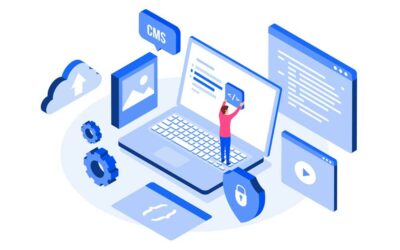Investing in a website is a smart first step to building a profitable business. In fact, you are already several steps ahead of the 45% of businesses that still don’t have a website.
Now that you have taken the first step, what is the next step?
If you are not sure how to use a website to make your business profitable, you are not alone.
One reason why 45% of small businesses still don’t have a website is that the owners are not sure what it does and how it works to contribute to profitability.
The truth is, running a small business website is not that difficult or complicated. Yes, there is a learning curve to overcome and it will take some time before you can see the fruits of your labor.
However, with patience and diligence, your website can become a profit-generating machine for your business.
So what is the next step? Read the article and find out how to use your website to make your business profitable.
Why Your Website Is The Most Powerful Marketing Tool For Your Business
Unlike a brick-and-mortar business, your website is open 24/7. It can be accessed by millions – even by billions – of people who are on the Internet every day.
Can you imagine owning a retail store that is open 24/7? You can have sales transactions every hour! People will be buying after close-of-business hours and keep your cash registers ringing.
This is possible with an online retail or e-commerce store. Your customers will simply click on your URL or website address, land on your homepage, read through your product list, then pay for the transaction at the checkout counter.
Through it all, you could be playing catch with your son, watching your daughter’s piano recital, having a glass of red wine with the spouse, or in the REM stage of a good night’s sleep.
Sounds too good to be true?
Well, it’s not!
There are many online entrepreneurs who are reaping the success of running a profitable Internet-based business.
These online entrepreneurs are not exceptions to the rule. Anyone can have a dynamic website that helps the business earn considerable income and become highly profitable.
The key is to learn how to harness the power of your website so you can maximize the opportunities that can be found on the Internet.
1. Make Sure Your Website Is Mobile Responsive
We have written a good number of articles on the importance of having a mobile responsive website.
We did not stop there.
In our other articles on digital marketing and website design, mobile responsive is always mentioned.
Here are 4 statistics-backed reasons why your website should be mobile responsive:
- Nearly 50% of Internet traffic worldwide originates from mobile devices.
- Sales conversion rates are 64% higher on mobile devices.
- 40% of consumers will click out of a website that is not mobile responsive.
- Do you own an e-commerce business? 87% of consumers use mobile devices to run product checks.
Having a website is a start but complete the project by making sure it is highly mobile responsive. By this, we mean that your website should have no problem setting up on the screen of a mobile device regardless of screen size.
If your website is not mobile responsive, you will lose business. Worse, not having a mobile responsive website can even prove to be damaging to your business.
Imagine clicking on a website from your smartphone and having to zoom-in and manually adjust the position of the page on your screen just to be able to read the content.
You will probably click out of the website.
Coincidentally, that is what your prospective customer will do if your website is not mobile responsive.
2. Optimize Your Website
We have come across websites that are beautiful. They look elegant and the content on the site is very well-written.
Unfortunately, according to the websites’ analytics, very few people have seen them.
The website cannot be seen because they cannot be found. They cannot be found because the websites are not optimized.
Search Engine Optimization (SEO) is the process of using techniques and processes that will increase the search visibility of your website on the Internet.
Without SEO, it does not matter if your website homepage looks like it should be on the Louvre Museum in Paris, France or if the content reads like it was written by Leo Tolstoy.
Hardly anyone will find it unless you have it optimized.
Here are 4 areas that you should look into to have your website optimized for easy search.
- Keyword Research – Keywords are the most-often used words or phrases when someone launches a search query. Having your website content embedded with the right keywords will make it easier for the search engine crawlers to index your page.
- Site Navigability – The navigability of a page plays an important factor in User Experience of which Google is big on. If you want your website to convert, you must make it easy for the visitor to use. If the visitor feels like he is trapped in a labyrinth, he will just click out.
- Meta and Title Tags – Meta and Title tags are the responsibility of the web developer. These are descriptions of your website that are included in its code. Title tags describe what your website is all about and can be seen on the results page. Meta tags are hidden within the code but are used to validate the type of website that you have.
- Site Speed – Although it takes 8.66 seconds to download the top ranking websites in Google, Internet searchers still expect a website to download in 3 seconds or less. 53% of users will leave a website if it does not download in under 3 seconds.
3. Focus On Your Website Homepage
An argument can be made that the Homepage is the most important page on your website. This is because is the page where a visitor will land after he clicks on your URL.
Having an effective website homepage means having one that is efficient – it should get the job done in no more than 6 seconds.
If the site visitor does not see anything useful, relevant, and compelling on your website within 6 seconds, he will click out.
What then makes an efficient website homepage?
- Less Is More – Have you come across a website that has so many things happening on the homepage? There is so much text. The homepage copy feels like reading a long-form blog.
Likewise, there are too many images and it seems that the color choices were made without thought or purpose.
When designing a homepage, the rule is less is more. Too much activity on the homepage will only serve to distract the site user not help him find what he is looking for.
- What Is Your Brand Value Proposition (BVP)? – The Brand Value Proposition or BVP is a statement that tells site visitors what your business can do for them. The BVP is the most important statement on your homepage and perhaps on your entire website. As mentioned, you only have fewer than 6 seconds to catch the interest of the site visitor. This is where the BVP comes in. It must be short, direct-to-the-point, and easily understood.
- How Compelling Is Your Call-To-Action (CTA)? – The Call-To-Action (CTA) tells the site visitor what you want him to do. To be effective the CTA must be direct-to-the-point. It should state urgency and the importance of acquiring your products and services right now.
You can make your homepage more compelling by adding testimonies or explainer videos. However, from both a design and functional perspective, less is more.
We recommend prioritizing the BVO and coming up with an effective CTA. From there, you could consider a slide featuring testimonies from actual clients or customers.

4. Blog Actively
People spend 23% of their time online reading blogs.
That statement should be enough to emphasize our point on the importance of blogging actively for your business.
However, before you blog actively, it would be best to understand what makes a blog effective.
Blogging is not as simple as writing about a topic you like or specialize in. We have clients who are experts in their field. They create blogs that are packed with information acquired from the years invested in the industry.
Yet, hardly anyone reads them. So, they get discouraged from blogging. By doing so, they fail to realize the benefits of blogging.
There are 2 reasons why their blogs do not gain traction and fail to deliver the desired results:
- The blogs are not optimized for search.
- The blogs are not written for the audience.
Blogging is not the same as writing a college term paper or a piece on a broadsheet. It combines the creativity of writing and the precision of digital technology.
Yes, you need a good writer who can create compelling pieces that are free of spelling and grammatical errors. However, these must be optimized so that the blogs can be searched and found on the Internet.
Optimizing a blog involves a number of processes, some of which we will discuss here:
- Keywords – We mentioned the importance of keywords in optimizing a website. The same can be said for your blogs. In order to be found your blog should contain the most-searched keywords in your industry. Therefore, in addition to topic research, your content creation strategy should include keyword research.
- Structure – Do you find reading a thickly-worded paragraph a pleasant experience? Not many people do. Too many sentences in a paragraph can turn reading into a tedious experience. To improve readability, the paragraphs should only contain 3-4 sentences. Consequently, each sentence should have no more than 40 words. Ideally, 20-25 words per sentence are best for optimization purposes.
- Content – An effective blog should have content that is fresh or unique, relevant, useful, informative, and compelling. It doesn’t matter if you have the best keywords in the right density. If your content does not meet the criteria, it will not be read.
We cannot overemphasize the importance of blogging. However, you need to have blogging done right.
We have published several blogs that have been recognized as among the best in the digital marketing industry. If you need help in blogging, we are the agency to go to!
5. Stay Active Online
The best way to stay top-of-mind on the Internet is to stay active online.
Let us go back to blogging.
According to research, you should blog at least 11 times per month in order to achieve the best results in sales conversions and website traffic.
What is the ideal length of a blog post for SEO purposes? According to a study by Search Engine Journal, your blogs should average 1,900 words.
That is a lot of writing per week!
Then, you have to publish the blogs on various online channels such as social media, blogging communities, and of course, your own website.
That is a lot of work!
However, you have the option of outsourcing these tasks to third-party agencies such as Mountaintop Web Design. This way, you can free up your time to focus on activities that are directly involved with your business.
The bottom line is that in order to stay relevant, you have to maintain an active presence online through blogging and frequent posting of content.
6. Fortify Site Security
Last July 2018, search engine giant Google started flagging websites without SSL certificates as “Not Secure”.
Having your website labeled as “Not Secure” by the Internet’s biggest search engine is enough to drive away interest from your business.
Google decided to impose SSL certificates to all websites because of the growing threat of cyber-security. As you well know, Google is big on User Experience.
You can learn more about SSL certificates and their importance for maintaining security for your website in our article “SSL Basics: Why You Need It To Protect Your Website From Hackers”.
Encourage site visitors to enter your website by securing it with SSL certificates. It is very easy to get SSL certificates and they will help protect your data from being stolen by cyber-criminals.
Conclusion
The website is more than just a business address on the Internet. It is your digital hub online where all transactions take place. Because of your website, your products and services can be accessed by a wider audience. It will give you the platform to build your reputation as a reliable resource in the industry.
Once your website goes live, it allows you to capitalize on the opportunities on the Internet that can make your business profitable.
However, a website will not run on its own.
You have to institute processes and techniques that are designed to drive traffic to your website. If done properly, these processes and techniques – such as the ones discussed in this article – will deliver results and make your business very profitable.
If you like this article, please feel free to share it in your community. And if you want to learn more about our services, let’s discuss it over your favorite brew!






